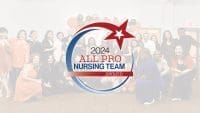Jeff Rawson, a new nurse graduate, works on a behavioral health unit. His manager believes his transition is going well—until Jeff asks to transfer to another unit. When she talks with him about it, he says he doesn’t feel a sense of belonging on the unit and has had difficulty establishing close relationships with coworkers.
Jeff’s feeling of being disconnected from colleagues should concern his manager and other unit staff. Feeling a sense of community in the workplace and establishing close relationships with coworkers are tied closely with job satisfaction, especially among new nurse graduates. They’re also important in establishing a healthy work environment.
In today’s workplace, developing trusting relationships also is a significant emotional compensation. That was one of the 12 key discoveries from a multiyear research effort by The Gallup Organization. Their staff satisfaction survey, one of the most widely used in the healthcare field, asks, “Do you have a best friend at work?” Having such a friend links directly to staff retention and loyalty to the organization. Gallup found the best managers assert that the quality and depth of employees’ relationships with one another is critical to employee loyalty.
Why a sense of community matters
A sense of community is crucial because staff may spend as much time with one another at work as they do with family members. Also, for some, work may be their only source of community, so it matters even more. During tough times like these, leaders should emphasize building community, camaraderie, and a sense of teamwork. When nurses feel a strong engagement, they’re more likely to believe their coworkers will help them during stressful and challenging times.
We also know from nursing research that nurses have an innate need to feel connected and valued as members of a community. This sense of community must extend beyond the nursing staff to interdisciplinary team members and support staff who spend time on the unit. To deliver patient-centered care and improve patient satisfaction, every staff member must feel a unified commitment. That starts with a sense of belonging and ownership.
Building blocks of community
The actions below can help you create an environment that promotes a sense of community on your nursing unit.
Align staff around a sense of purpose and values
The sense of community grows when all staff members have common values and share the same vision about the purpose of work. We sometimes assume this shared vision exists—but that may be an illusion. Leaders should initiate a discussion with staff and elicit their ideas about purpose and values so they can build a consensus. To create an environment of quality, safety, and patient-centeredness, staff need to feel strongly connected to the mission and to their overall contribution to patient care.
The Baptist Health Leadership group suggests three key questions to ask employees to start building a shared sense of purpose:
- What is our mission?
- What are we striving to become (our vision)?
- What guides our everyday behavior (our values)?
Be inclusive
To build a strong community, everyone must feel like a valued member, including interdisciplinary team members and housekeeping and engineering staffs. Inclusivity begins with unit leaders acknowledging the presence and knowing the names of staff members who work on the unit. In Unaccountable: What Hospitals Won’t Tell You and How Transparency Can Revolutionize Health Care, the author questions how an organization can hope to build a culture of communication if colleagues work in complete anonymity. When people come to know each other by name, he observes, they’re more likely to act with civility. Anonymity, on the other hand, fosters incivility.
Value individual differences
Part of the joy of being human is recognizing we’re all different and have unique gifts. To build community, leaders must recognize individual differences and capitalize on each person’s strengths. In First, Break all the Rules: What the World’s Greatest Managers Do Differently, the authors reveal that their research shows the greatest managers capitalize on the strengths of staff members and minimize their weaknesses. Today we have four generations in the workforce, each with different values, beliefs, and attitudes. It’s easy to get blinded by our own generational values and fail to see the strengths in others. Valuing individual differences promotes team synergy.
Encourage an environment of trust
Strong communities share an environment of trust and psychological safety. Nurses can promote this trust by refusing to gossip, speculate, or criticize colleagues who aren’t present. Where psychological safety exists, staff members feel confident they’ll get others’ respect and consideration; open discussion of tough issues is encouraged and differing viewpoints aren’t just tolerated but nurtured.
Create opportunities for staff to tell their stories
In some workplaces, staff members know little about each other. To help build community, create opportunities for them to learn more about one another and what’s important to them in their work. Huddles and staff meetings can be great opportunities to do this. Leaders should take the time to learn about their staff, including important days, such as birthdays, and their children’s and spouses’ names. Some staff members may live alone and lack family or friends; for them, work is an important connection.
Embrace conflict
Conflict is an inevitable part of teamwork—but leaders should seek ways to reduce tension. In a workplace where unit staff see each other infrequently, conflict can build and go unresolved. Sometimes people need to agree to disagree. Help staff develop conflict-resolution skills.
Look for opportunities to celebrate
Celebrating special events, birthdays, and staff achievements is an important way to build community. Most nurses would agree that sharing meals is critical to promoting staff camaraderie, but be consistent in such celebrations. Participating in community events, such as “heart walks” or a United Way drive also can build unit camaraderie.
What’s the payoff?
A sense of community energizes staff. With staff members working different tours, building a sense of community can pose a challenge, but the rewards are worth it. Units with a community feeling have more open communication. Research shows a sense of community promotes delivery of safer, higher-quality care and that building community on nursing units promotes nurse retention. Employee morale and staff satisfaction improve while absenteeism declines. Staff members look forward to coming to work and don’t want to let team members down.
Experts predict that within a few years, we’ll see a significant nursing shortage. Nurses and healthcare professionals will have more career options than ever. A strong sense of community on your unit and in your organization can make a big difference in keeping staff nurses. On units with an inclusive, supportive atmosphere, staff will be reluctant to break those bonds.
Selected references
American Association of Critical Care Nurses. AACN Standards for Establishing and Sustaining Health Work Environments: A Journey to Excellence. Am J Crit Care. 2005;14(3):187-97.
Baker AB, Leiter MP (eds). Work Engagement: A Handbook of Essential Theory and Research. London: Psychology Press; 2010.
Buckingham M, Coffman C. First, Break All the Rules: What the World’s Greatest Managers Do Differently. New York: Simon and Schuster; 1999. Buckingham M, Coffman C. Item 10: I have a best friend at work. Gallup Business Journal. May 26, 1999. www.consociates.com/pages/C2cpeople_lit/GallupGreatWorkplace/GreatWorkplace10.html. Accessed January 8, 2013.
Makary M. Unaccountable: What Hospitals Won’t Tell You and How Transparency Can Revolutionize Health Care. New York: Bloomsbury Press; 2012.
Manion J, Bartholomew K. Community in the workplace: A proven retention strategy. J Nurs Adm. 2004;34(1):46-53.
Schmalenberg C, Kramer M. Clinical units with the healthiest work environments. Crit Care Nurs. 2008;28:65-77.
Sherman RO. One size doesn’t fit all: motivating a multigenerational staff. Nurs Manage. 2008;39(9):8-10.
Stubblefield, A. The Baptist Healthcare Journey to Excellence: Creating a Culture that WoWs! New York: Wiley; 2004.
Twibell R, St. Pierre J, Johnson D, Davis C, Kidd M, Rook G. Tripping over the welcome mat: Why new nurses don’t stay and what the evidence says that we can do about it. Amer Nurs Today. 2012;7(6). myamericannurse.com/article.aspx?id=9168&fid=9138. Accessed December 23, 2012.
Rose O. Sherman is an associate professor of nursing and director of the Nursing Leadership Institute at Christine E. Lynn College of Nursing, Florida Atlantic University, Boca Raton, Florida. You can read her blog at www.emergingrnleader.com.



















2 Comments.
Building a sense of community on nursing units is very important to get the job done effectively and safely. Having common value and vision mininize confusion and problems on the unit.
Building a sense of community on nursing units is very important to get the job done effectively and safely. Having common value and vision mininize confusion and problems on the unit.